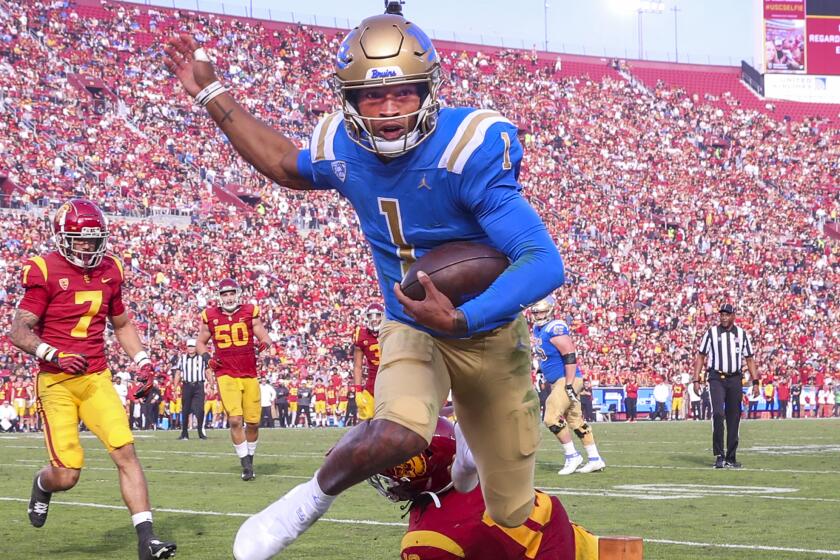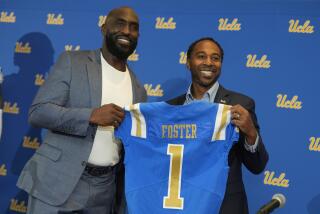How much money waits for UCLA and USC in the Big Ten Conference?

- Share via
It’s about name, image and likeness, they said. It’s about like-minded academic institutions. It’s about growing opportunities to recruit.
The true reason behind UCLA and USC’s drastic shift to the Big Ten Conference is much simpler than the language administrators use in long-winded statements.
It’s money.
With players being paid, universities have to follow the money, and UCLA and USC are making a smart move by leaving the Pac-12 for the Big Ten Conference.
With the Pac-12’s recent struggles and archaic TV deal, the conference’s teams were simply getting left behind, and jumping ship to the Big Ten gives USC and UCLA their best financial lifeline to compete in a college sports scene that is blurring the lines between professional and amateur more each day.
The Big Ten’s emergence as a financial titan began when the conference signed a six-year, $2.65-billion TV deal that began in 2017. At the time, the Pac-12 was outpacing the Big Ten in revenue thanks to a landmark TV deal under former commissioner Larry Scott.
That 12-year, $3-billion deal signed in 2011 tripled the conference’s annual TV revenues and created the Pac-12 Networks. It was the richest media rights deal in college sports at the time.
But it didn’t age well.
Hamstrung by the long-term deal and the failure of the Pac-12 Networks, the Pac-12 distributed only $33.6 million to each of its member institutions in 2019-20. The Big Ten offered, on average, $49.2 million that year to its 14 members, with the 12 longest-tenured institutions receiving on average $54.3 million. Maryland and Rutgers, which were not full members at that time, took home $27.6 million and $11.4 million, respectively. The $20-million difference between what USC and Ohio State continues into the following year.
The COVID-19 pandemic had major financial impacts on all athletic programs, but the Pac-12 especially suffered. The conference reported a 35.7% drop in revenue from the 2019-20 fiscal year to 2020-21 and distributed just $19.8 million to each school. The Big Ten fell by 11.6% but still distributed $47.8 million for each school.
The Big Ten’s 2017 media rights deal produced an average of $441.7 million in TV revenue a year. That number could double in the conference’s upcoming contract.
Initial reports indicate the Big Ten’s new deal that starts in 2024 could be worth a whopping $1 billion a year. That was before UCLA and USC signed on and brought the second-largest media market in the country.
Splitting $1 billion of annual TV revenue among 16 Big Ten schools yields an average of $62.5 million per school. That alone, before additional revenue streams such as NCAA men’s basketball tournament payouts and bowl games, is almost twice what UCLA earned from the Pac-12 two years ago.
USC and UCLA are leaving the Pac-12 for the Big Ten Conference in 2024, the two schools announced Thursday.
The money can go toward facility upgrades, salaries to attract and keep top coaches, and improved travel. UCLA athletic director Martin Jarmond said in a statement that the “resources” from the deal will help manage the logistical nightmares that will surely follow West Coast teams that have to travel at least 1,500 miles to get to their closest Big Ten foe, Nebraska.
In its statement announcing the move, USC also noted that, starting this upcoming academic year, all athletes could receive up to $5,980 annually in “direct financial support in the form of academic achievement awards, consistent with the Supreme Court’s recent Alston ruling.”
USC will have the means to increase that number substantially in two years.
More to Read
Go beyond the scoreboard
Get the latest on L.A.'s teams in the daily Sports Report newsletter.
You may occasionally receive promotional content from the Los Angeles Times.













